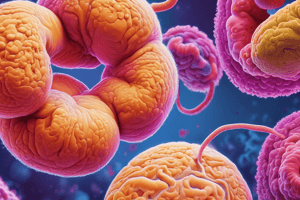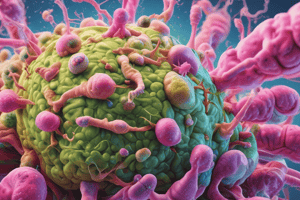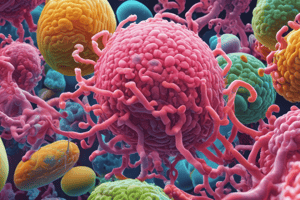Podcast
Questions and Answers
What is a consequence of HIV infection in the thymus?
What is a consequence of HIV infection in the thymus?
- Failure to regenerate more T cells (correct)
- Heightened T cell function
- Increased T cell regeneration
- Decreased production of B cells
Which organism is NOT a common secondary infection associated with a weakened immune system due to HIV?
Which organism is NOT a common secondary infection associated with a weakened immune system due to HIV?
- Escherichia coli (correct)
- Mycobacterium tuberculosis
- Cryptococcus neoformans
- Cytomegalovirus
What is one mechanism of pathogenicity that can lead to disease?
What is one mechanism of pathogenicity that can lead to disease?
- Producing antibodies
- Facilitating T cell proliferation
- Inhibiting microbial clearance
- Direct invasion of host cells (correct)
Which step is NOT part of the infection process discussed?
Which step is NOT part of the infection process discussed?
How does chronic inflammatory response affect T cells?
How does chronic inflammatory response affect T cells?
What is the primary route of transmission for rhinoviruses causing the common cold?
What is the primary route of transmission for rhinoviruses causing the common cold?
What is a key characteristic of the Bacillus anthracis organism?
What is a key characteristic of the Bacillus anthracis organism?
Which anthrax type has the highest fatality rate if untreated?
Which anthrax type has the highest fatality rate if untreated?
What is a common symptom of cutaneous anthrax?
What is a common symptom of cutaneous anthrax?
What is the mode of infection for gastrointestinal anthrax?
What is the mode of infection for gastrointestinal anthrax?
What factor contributes to the pathogenicity of Bacillus anthracis?
What factor contributes to the pathogenicity of Bacillus anthracis?
What is the typical onset period for inhalation anthrax?
What is the typical onset period for inhalation anthrax?
What symptom is associated with injection contracted anthrax?
What symptom is associated with injection contracted anthrax?
What prevents vegetative bacteria cells from being destroyed by the immune system?
What prevents vegetative bacteria cells from being destroyed by the immune system?
Which toxin is responsible for hyperinflammation via MAPKK?
Which toxin is responsible for hyperinflammation via MAPKK?
What are some common signs of influenza syndrome?
What are some common signs of influenza syndrome?
Which microorganism is NOT associated with upper respiratory tract infections?
Which microorganism is NOT associated with upper respiratory tract infections?
What characterizes infectious diseases?
What characterizes infectious diseases?
What is the genetic material of the influenza virus?
What is the genetic material of the influenza virus?
Which of these is a route of transmission for respiratory tract infections?
Which of these is a route of transmission for respiratory tract infections?
What does the term 'influenza' derive from?
What does the term 'influenza' derive from?
Which type of inflammatory reaction is typically associated with mycobacterial infections such as leprosy?
Which type of inflammatory reaction is typically associated with mycobacterial infections such as leprosy?
Which stain is specifically used for identifying Histoplasma in tissue samples?
Which stain is specifically used for identifying Histoplasma in tissue samples?
What type of antibody would be used to identify Treponema pallidum in gastric syphilis?
What type of antibody would be used to identify Treponema pallidum in gastric syphilis?
Which method is NOT typically used for identifying microorganisms in tissue samples?
Which method is NOT typically used for identifying microorganisms in tissue samples?
What type of samples are typically analyzed using PCR for identifying microbial infections?
What type of samples are typically analyzed using PCR for identifying microbial infections?
Which infectious disease has been associated with the development of resistance to antimicrobial drugs as an emerging disease?
Which infectious disease has been associated with the development of resistance to antimicrobial drugs as an emerging disease?
Which type of tissue stain would you use for visually identifying Cryptococcus in a biopsy sample?
Which type of tissue stain would you use for visually identifying Cryptococcus in a biopsy sample?
What is one limitation of immunohistochemistry in identifying microorganisms in tissue samples?
What is one limitation of immunohistochemistry in identifying microorganisms in tissue samples?
What is the primary purpose of determining the cause of an infectious disease?
What is the primary purpose of determining the cause of an infectious disease?
Which of the following is NOT classified as a causative agent of infectious disease?
Which of the following is NOT classified as a causative agent of infectious disease?
What type of transmission involves inhalation of air droplets containing microorganisms?
What type of transmission involves inhalation of air droplets containing microorganisms?
Which of these routes of transmission is associated with eating contaminated food?
Which of these routes of transmission is associated with eating contaminated food?
Which infectious agent is specifically non-cellular?
Which infectious agent is specifically non-cellular?
What characteristic distinguishes fungi as a type of infectious agent?
What characteristic distinguishes fungi as a type of infectious agent?
Which of the following microbe types has not yet been identified as an infectious agent?
Which of the following microbe types has not yet been identified as an infectious agent?
Which organism type is typically a vector for transmitting infectious agents?
Which organism type is typically a vector for transmitting infectious agents?
What is the incubation period in the phases of infectious disease?
What is the incubation period in the phases of infectious disease?
Which characteristic describes chronic diseases?
Which characteristic describes chronic diseases?
How does a systemic disease differ from a local disease?
How does a systemic disease differ from a local disease?
What typically characterizes the decline phase of an infectious disease?
What typically characterizes the decline phase of an infectious disease?
What type of disease is characterized by no symptoms between outbreaks and illness?
What type of disease is characterized by no symptoms between outbreaks and illness?
Which is true of a primary infection?
Which is true of a primary infection?
When does the recovery phase of an infectious disease occur?
When does the recovery phase of an infectious disease occur?
What is an example of an acute disease?
What is an example of an acute disease?
Flashcards
Infectious Disease
Infectious Disease
A disease caused by a contagious agent that transmits and causes an infection. It affects tissues and cells, leading to pathological effects.
Infectious Disease Etiology
Infectious Disease Etiology
The scientific study of infectious disease, including its causes, transmission, prevention, and treatment.
Microorganisms or Microbes
Microorganisms or Microbes
Tiny organisms that can cause infectious diseases, such as bacteria, viruses, fungi, and protozoa.
Transmission of Infectious Agents
Transmission of Infectious Agents
Signup and view all the flashcards
Aerosol Transmission
Aerosol Transmission
Signup and view all the flashcards
Oral Transmission
Oral Transmission
Signup and view all the flashcards
Direct Contact Transmission
Direct Contact Transmission
Signup and view all the flashcards
Fomite Transmission
Fomite Transmission
Signup and view all the flashcards
Bacterial Capsule: Defense Mechanism
Bacterial Capsule: Defense Mechanism
Signup and view all the flashcards
Edema Toxin
Edema Toxin
Signup and view all the flashcards
Lethal Toxin
Lethal Toxin
Signup and view all the flashcards
Septicemia
Septicemia
Signup and view all the flashcards
Signs of Infectious Disease
Signs of Infectious Disease
Signup and view all the flashcards
Symptoms of Infectious Disease
Symptoms of Infectious Disease
Signup and view all the flashcards
Anthrax
Anthrax
Signup and view all the flashcards
Cutaneous Anthrax
Cutaneous Anthrax
Signup and view all the flashcards
Inhalation Anthrax
Inhalation Anthrax
Signup and view all the flashcards
Gastrointestinal Anthrax
Gastrointestinal Anthrax
Signup and view all the flashcards
Injection Anthrax
Injection Anthrax
Signup and view all the flashcards
Anthrax toxin
Anthrax toxin
Signup and view all the flashcards
Bacillus anthracis Spores
Bacillus anthracis Spores
Signup and view all the flashcards
Bacillus anthracis Spore Germination
Bacillus anthracis Spore Germination
Signup and view all the flashcards
Incubation Period
Incubation Period
Signup and view all the flashcards
Prodromal Phase
Prodromal Phase
Signup and view all the flashcards
Clinical Phase
Clinical Phase
Signup and view all the flashcards
Decline Phase
Decline Phase
Signup and view all the flashcards
Recovery Phase
Recovery Phase
Signup and view all the flashcards
Acute Disease
Acute Disease
Signup and view all the flashcards
Chronic Disease
Chronic Disease
Signup and view all the flashcards
Latent Disease
Latent Disease
Signup and view all the flashcards
Purulent Inflammation
Purulent Inflammation
Signup and view all the flashcards
Granulomatous Inflammation
Granulomatous Inflammation
Signup and view all the flashcards
Fibrinous Inflammation
Fibrinous Inflammation
Signup and view all the flashcards
Lymphocytic Inflammation
Lymphocytic Inflammation
Signup and view all the flashcards
Immunohistochemistry
Immunohistochemistry
Signup and view all the flashcards
In Situ Hybridization (ISH)
In Situ Hybridization (ISH)
Signup and view all the flashcards
Electron Microscopy (EM)
Electron Microscopy (EM)
Signup and view all the flashcards
Molecular Biology (PCR)
Molecular Biology (PCR)
Signup and view all the flashcards
How HIV Impacts the Immune System
How HIV Impacts the Immune System
Signup and view all the flashcards
Opportunistic Infections
Opportunistic Infections
Signup and view all the flashcards
Pathogenesis of Infectious Diseases
Pathogenesis of Infectious Diseases
Signup and view all the flashcards
Steps of Infection
Steps of Infection
Signup and view all the flashcards
Immune Response in Infection
Immune Response in Infection
Signup and view all the flashcards
Study Notes
Infectious Diseases
- Infectious diseases are caused by contagious agents that can transmit infection and cause pathological effects in tissues and cells.
- Determining the cause is crucial for diagnosis, treatment, prognosis, and prevention.
- Infectious diseases are often easily transmitted, especially through air and water.
- Causative agents are microscopic organisms (microbes).
- Transmission routes include aerosol, oral, direct contact, fomite, vector-borne, and zoonotic.
Etiological Agents
- Bacteria (prokaryotes)
- Viruses (non-cellular)
- Fungi (eukaryotes)
- Protozoa (eukaryotes)
- Prions (proteins, non-cellular)
- Helminths (non-microbial, eukaryotes)
- Arthropods (non-microbial, eukaryotes)
- Archaea (no known infectious agents, but possible role in periodontal disease)
Bacillus anthracis
- Gram-positive bacilli forming endospores. Found in the environment.
- Causes cutaneous, gastrointestinal, inhalation, and injection anthrax.
- Cutaneous anthrax (most common, 95%): wound contamination from spores.
- Gastrointestinal anthrax: ingestion of spores.
- Inhalation anthrax: inhalation of spores.
- Injection anthrax: needles contaminated with soil or material (swelling, nausea, vomiting).
- Welders' anthrax: B. cereus group creating anthrax toxin (pneumonia-like symptoms).
- Pathogenesis involves spore germination, phagocytosis, lymph spread, and prevention of phagocytosis by a capsule.
- Toxins include edema toxin, lethal factors, and protective antigen.
- May cause septicemia, brain, and meningeal infection or pulmonary blockage.
Transmission Routes and Airborne Pathogens
- Many microorganisms can spread by inhaling airborne droplets.
- Upper respiratory tract pathogens: Staphylococcus aureus, Neisseria meningitidis, Streptococcus pyogenes, Corynebacterium diphtheriae, Haemophilus influenzae, common cold virus.
- Lower respiratory tract pathogens: Influenza virus, Mycobacterium tuberculosis, Coccidioides immitis, Bordetella pertussis, Streptococcus pneumoniae, pneumonia viruses, Coxiella burnetii, Chlamydophila pneumoniae.
Characteristics of Infectious Diseases
- Signs: observable effects (fever, cough, vomiting).
- Symptoms: subjective experiences (pain, nausea).
- Influenza syndrome: caused by influenza virus.
- Influenza virus genome: segmented negative-sense single-stranded RNA (ssRNA) with pleomorphic nucleocapsid.
Phases of Infectious Diseases
- Incubation period: time between infection and symptoms.
- Prodromal phase: mild, non-specific symptoms.
- Clinical phase: typical signs and symptoms appear.
- Decline phase: symptoms subside.
- Recovery phase: symptoms disappear, tissues heal.
Types of Infectious Diseases by Duration, Location, and Timing
- Acute diseases: develop and progress quickly (e.g., Ebola).
- Chronic diseases: develop slowly and last longer (e.g., HPV).
- Latent diseases: no symptoms between outbreaks and illness (e.g., HSV).
- Local diseases: confined to a specific area (e.g., ringworm).
- Systemic diseases: infect multiple body sites and tissues.
- Primary infections: initial infection in a healthy person.
- Secondary infections: infections resulting from a weakened immune system. (e.g., HIV)
Pathogenesis of Infectious Diseases
- Mechanisms: production of toxins and enzymes, direct invasion, triggering immune responses.
- Steps in infection: entry, attachment, colonization, spread, replication, evasion of immune response, exit.
Immune Response and Pathology
- Immune responses can contribute to disease pathology by blocking, deactivating, and clearing the pathogen.
- Some pathological effects result from more than one agent.
- Common shared pathologies: respiratory infections, bloodstream infections, encephalitis, meningitis, endocarditis, gastrointestinal diseases, and skin & soft tissue infections.
Skin and Soft Tissue Infections
- Localizations: epidermis (impetigo), dermis (erysipelas), hair follicles (folliculitis, boils, carbuncles), subcutaneous fat (cellulitis), fascia (necrotizing fasciitis), muscle (gangrene).
- Causative agents: Streptococcus pyogenes, Staphylococcus aureus, anaerobes, Clostridium perfringens.
- Viral examples: Papilloma, HSV, VZV.
Skin Manifestations by Systemic Infections and Diagnosis Methods
- Skin signs can indicate systemic infections.
- Diagnosis methods: microscopy (e.g., Ziehl-Neelson, Gomori Grocott), immunohistochemistry (antibodies for pathogens) and molecular biology techniques like PCR and ISH.
Emerging Infectious Diseases
- Emerging diseases are those newly appearing or rapidly increasing in incidence.
- Factors include antimicrobial resistance, spread to new hosts, ineffective preventative measures, and unknown agents.
Enteric Fever (caused by S. Typhi)
- Gram-negative bacteria.
- Human-specific.
- Symptoms include high fever, headache, nausea, abdominal pain, constipation, and diarrhea.
- S. Typhi uses Vi capsule for attachment employing N-acetylneuraminic acid (Neu5Ac) sialoglycans.
Infectious Disease Management
- Treatment: antibiotics (bacteria), antiviral drugs (viruses), antifungal drugs (fungi).
- Prevention: vaccines, good hygiene, vector control, isolation/quarantine.
- Diagnosis: clinical presentation, laboratory tests.
Epidemiology
- Epidemiology is the study of disease occurrence in populations.
- Four branches: disease etiology, outbreak investigation, disease screening/surveillance, and clinical trials (treatments or effects).
Studying That Suits You
Use AI to generate personalized quizzes and flashcards to suit your learning preferences.




